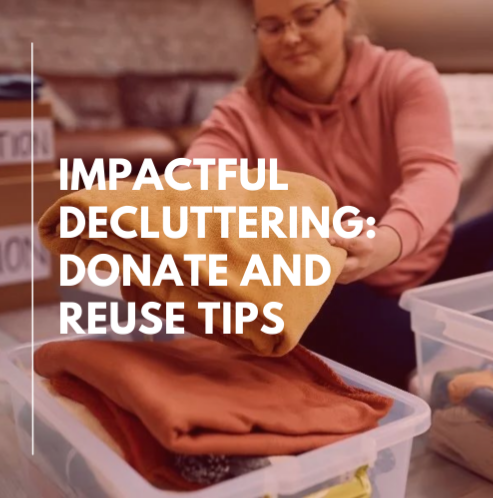Decluttering your home can be a transformative experience, both for your living space and for the environment. By focusing on donation and reuse, you can reduce waste, help those in need, and create a more organized and serene home. This guide provides practical tips for impactful decluttering, emphasizing sustainable practices that benefit both you and your community.
The benefits of decluttering through donation and reuse are numerous.
Environmental Impact
Decluttering through donation and reuse significantly reduces the amount of waste that ends up in landfills. This not only minimizes environmental pollution but also conserves resources by extending the lifecycle of items. Reusing items reduces the demand for new products, thereby lowering the environmental footprint associated with manufacturing and transportation.
When you donate and reuse, you contribute to the reduction of greenhouse gas emissions. Manufacturing new items typically involves extracting raw materials, processing them, and transporting the final product, all of which contribute to carbon emissions. By opting to reuse and donate, you help curb this cycle and promote a more sustainable way of living.
Social Contributions
Donating items in excellent condition to local charities, shelters, and community organizations supports those in need. It provides an opportunity for others to benefit from items you no longer use, fostering a sense of community and generosity. For instance, animal shelters often need towels, blankets, and pet supplies, while local schools and daycares can benefit from books, toys, and educational materials.
Additionally, by donating to thrift stores and non-profit organizations, you help support their mission of providing affordable goods to those in need. Many organizations, such as Goodwill and the Salvation Army, use proceeds from sales to fund job training programs, housing assistance, and other community services.
Personal Satisfaction
Decluttering your home and donating items can bring a sense of accomplishment and peace. Letting go of unnecessary items creates a more organized and serene living space, reducing stress and making it easier to maintain a clean and tidy home. The act of giving also provides emotional satisfaction, knowing that your donations are making a positive impact on others.
Practical Tips for Decluttering Through Donation and Reuse
- Start Small and Stay Focused
Begin your decluttering journey by tackling small areas, such as a single drawer or closet. This approach helps you build momentum and prevent overwhelm. Set aside time each day or week to focus on specific areas of your home. By breaking the task into manageable chunks, you can steadily progress without feeling overwhelmed.
Consider starting with high-traffic areas like the entryway or kitchen, where clutter tends to accumulate quickly. These spaces often contain items that are simple to sort and donate, such as shoes, outerwear, and kitchen gadgets. As you see immediate results, you’ll feel motivated to continue with other areas of your home.
- Use the three-box method.
The three-box method is a simple yet effective way to sort your items. Label three boxes as “Keep,” “Donate,” and “Dispose.” As you go through each item, decide which box it belongs in. This method helps streamline the decluttering process and ensures that you are making thoughtful decisions about what to keep and what to give away.
Be honest with yourself about each item’s practicality and sentimental value when using this method. Ask yourself if you have used the item in the past year, or if it brings you joy. If the answer is no, it’s time to let it go. For items in the “Dispose” box, make sure to recycle or properly dispose of them to minimize environmental impact.
- Donate Responsibly
Make sure the items you donate are in excellent condition and suitable for others to use. Commonly accepted items include clothing, shoes, accessories, kitchen goods, books, toys, and small appliances. Research local charities and donation centers to find out what items they accept and their drop-off procedures.
It’s important to check the condition of your donations before dropping them off. Items should be clean, functional, and free of major damage. Donation centers often have specific guidelines for what they can and cannot accept, so be sure to familiarize yourself with these to avoid burdening them with unusable items.
- Get Creative with Reuse
Reusing items creatively can save money and reduce waste. For instance, you can transform old T-shirts into cleaning rags and utilize glass jars for storage or as planters. Sites like Pinterest offer countless ideas for upcycling and reusing household items in innovative ways.
Consider reimagining the purpose of everyday items. You can transform an old ladder into a stylish bookshelf or a vintage suitcase into unique storage. These creative projects not only reduce waste but also add a personalized touch to your home decor.
- Recycle Properly
If you can’t donate or reuse items, recycling is the next best option. Check with your local recycling center to see what materials they accept. Common recyclable items include paper, cardboard, glass, and certain plastics. By processing and reusing these materials in new products, proper recycling reduces the need for virgin resources.
Recycling electronics, batteries, and other hazardous materials is particularly important, as improper disposal can lead to environmental contamination. Many electronics stores and community programs offer recycling services for these items. Utilizing these resources guarantees the safe disposal of hazardous materials.
- Maintain a Clutter-Free Lifestyle
To sustain the benefits of decluttering, adopt habits that prevent clutter from accumulating. Regularly assess your possessions and donate or recycle items you no longer need. Being mindful of new purchases and opting for high-quality, durable items can also help maintain an organized home.
Incorporate decluttering into your routine by setting aside a few minutes each day to tidy up. For example, dedicate 10 minutes before bed to put away items and clear surfaces. This daily habit will prevent clutter from building up and make larger decluttering sessions less daunting.
- Engage in Community Initiatives
Participating in community initiatives can enhance your decluttering efforts. Many communities organize swap meets, freecycle events, and donation drives that encourage residents to exchange or donate items they no longer need. These events are great opportunities to declutter responsibly while fostering community connections.
Joining local online groups or forums dedicated to decluttering and sustainability can also provide support and inspiration. Sharing your progress and challenges with others can keep you motivated and offer new ideas for organizing and reusing items.
- Teach and Encourage Others
By teaching and encouraging others to adopt these practices, spread the benefits of decluttering. Share your experiences and tips with friends, family, and neighbors. Organize group decluttering sessions or donation drives to collectively make a positive impact on your community.
Educating children about the importance of donating and reusing can instill sustainable habits from a young age. Involve them in sorting through toys, clothes, and other items they no longer use. Explain how their donations can help others and contribute to a cleaner environment.
Conclusion
Impactful decluttering through donation and reuse is a sustainable way to create a more organized and peaceful home. By donating items in excellent condition, you support your community and reduce waste. Reusing and recycling further minimize your environmental footprint, contributing to a healthier planet. Embrace these practices to enjoy the benefits of a clutter-free, sustainable lifestyle.
By following these tips, you can make a positive impact on your home and the environment while helping those in need. Happy decluttering


